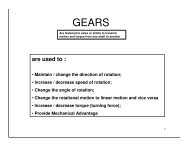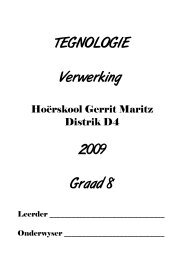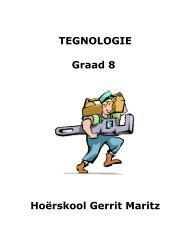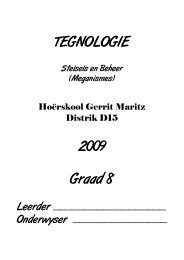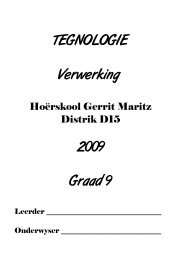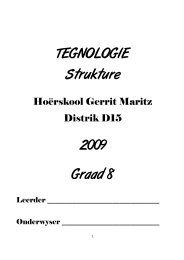TECHNOLOGY Processing 2009 Grade 8 - Tegnologie
TECHNOLOGY Processing 2009 Grade 8 - Tegnologie
TECHNOLOGY Processing 2009 Grade 8 - Tegnologie
You also want an ePaper? Increase the reach of your titles
YUMPU automatically turns print PDFs into web optimized ePapers that Google loves.
Wood<br />
Timberwood is very expensive and since it is a natural resource we should not abuse it.<br />
There are plantations which are grown with the purpose of supplying wood for wood products<br />
and paper. At these plantations fast growing trees are planted.<br />
The terms hardwood and softwood do not refer to the wood, but to the leaves of the trees:<br />
Softwoods come from trees with needle-like leaves; the most common types are pine, spruce<br />
and larch. Hardwoods come from broad-leaved trees; they include oak, ash and beech from<br />
the temperate zones, and a wide variety of tropical hardwoods such as mahogany, meranti<br />
and jelutong. Not all hardwoods are hard - balsa is very soft.<br />
Manufactured board<br />
Manufactured board is made by glueing together layers of woodfibres of veneers. It is usually<br />
made with leftover wood and has mainly been developed for industrial use, since it is possible<br />
to make many similar sheets of baord.<br />
This type of wood is much cheaper than real wood, but because the appearance is not as<br />
attractive as the real thing, a veneer is often glued as a top layer.<br />
Types of manufactured board are: plywood, laminated board, chip board, softboard, fibre<br />
board and softboard.<br />
Composite materials<br />
When two or more materials with different properties are combined, they form a composite<br />
material. The different materials work together to create a new material, which has the<br />
propeties of both. The two materials can clearly be distinguished in the new composite<br />
material.<br />
Examples:<br />
Mud and straw bricks<br />
Humans have been using composite materials for a long time in order to build our dwellings.<br />
Some of the earliest forms of building were built of mud bricks. Mud bricks work well when<br />
they are being compressed (compression forces) but a cake of mud is easily broken if it is bent<br />
(bending forces). This is because the act of bending places a tension force on one edge.<br />
At the same time as the mud block buildings were being built other people were making straw<br />
dwellings. Straw has a great deal of tensile strength (resistance to pulling forces) but it is very<br />
weak when crumpled. These early builders realised was that if straw, which has a good tensile<br />
strength was embedded in a block of mud, which has good compressive strength and left to<br />
dry the resulting brick would resist both tearing and squeezing. These composite bricks made<br />
excellent building materials.<br />
Car tyres<br />
Modern tyres are constructed of layers, which may include rayon cloth, steel bands and nylon<br />
belts all set in a matrix (binder) of rubber.<br />
Concrete<br />
Concrete is made from small stones and gravel called aggregate, sharp sand and cement. The<br />
small stone and gravel (aggregate) is the reinforcement and the cement is the matrix that<br />
binds it together. Concrete has good strength under compression but it is weak in tension. It<br />
can be made stronger under tension by adding metal rods, wires, mesh or cables to the<br />
composite. The concrete is cast around the rods. This is called reinforced concrete.<br />
Veselglas<br />
Consists of two distinct materials, a fibres of glass (ceramic), which is the reinforcement and a<br />
polymer resin called polyester, which serves as the matrix. The polyester resin polymer alone<br />
is brittle and has a low strength but when fibres of glass are embedded in the polymer it<br />
becomes strong, tough, resilient and flexible. It becomes an ideal material to make boat hulls,<br />
swimming pool linings, car bodies, roofing and furniture.





